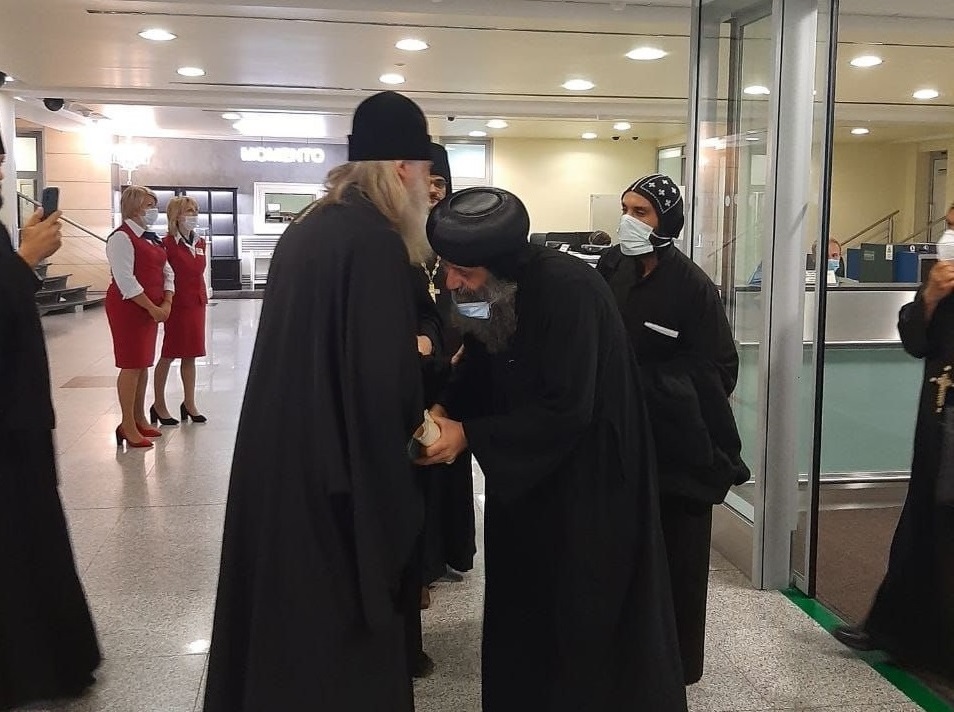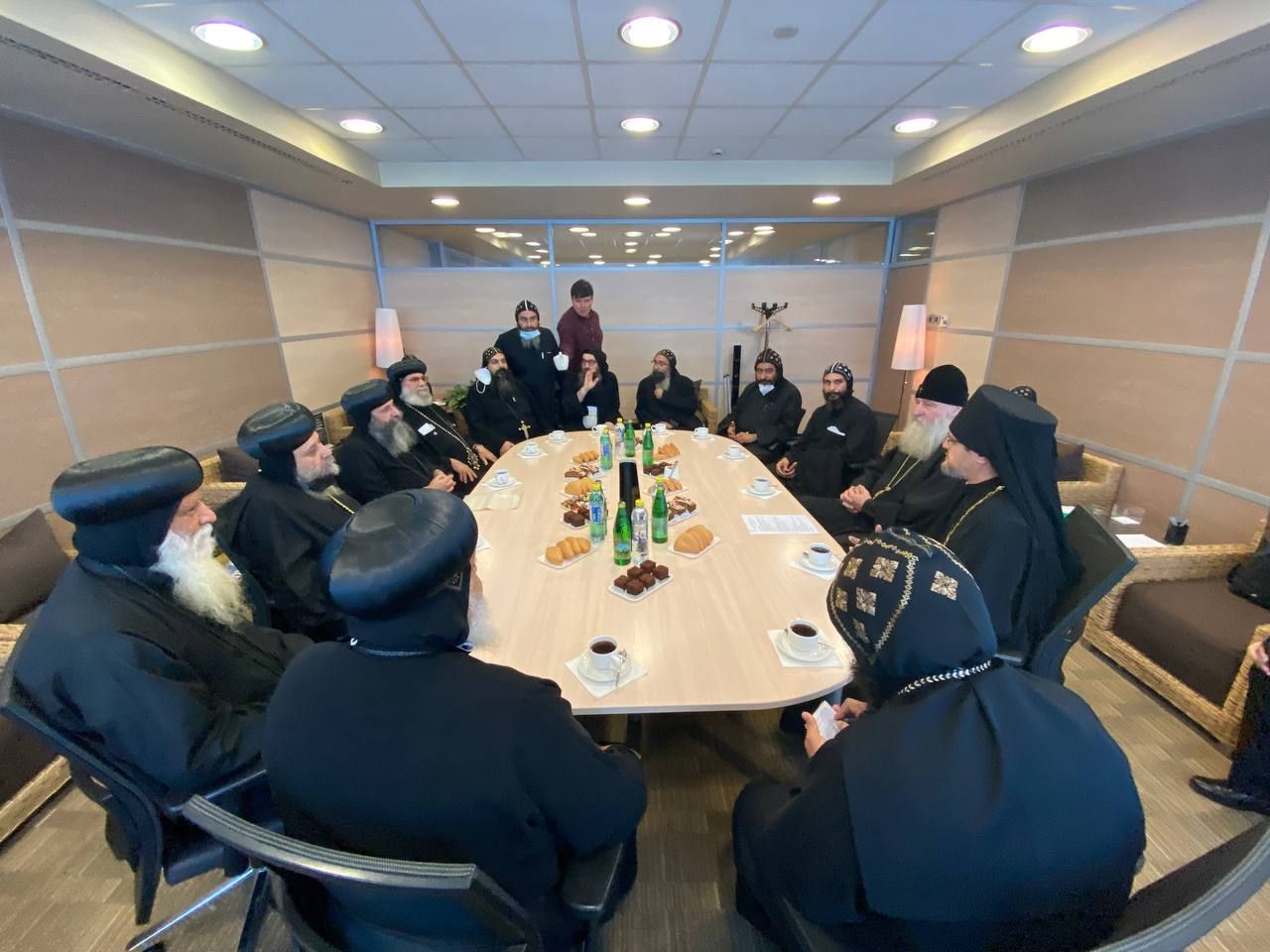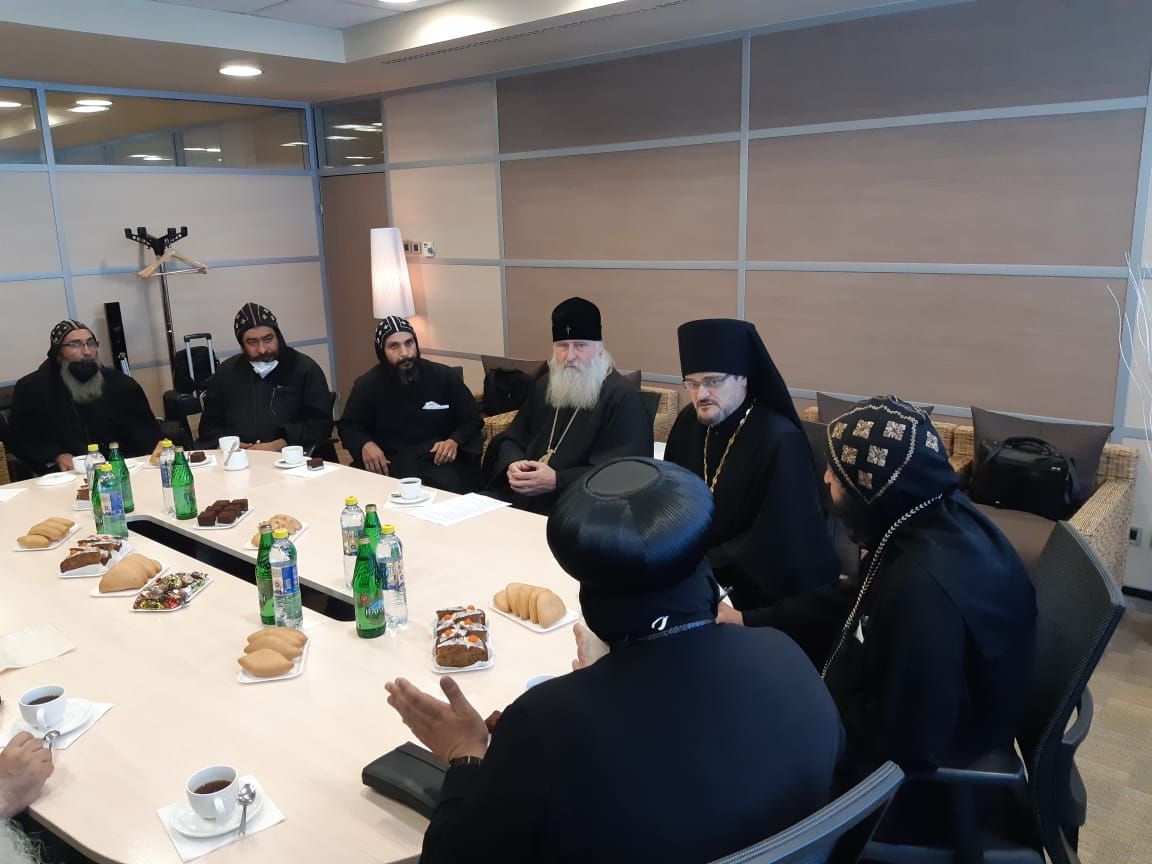Delegation of Abbots and Monks from Egyptian Monasteries Comes to Russia



The present visit is coming at a time of growing dialogue between the Russian Orthodox Church and the Coptic Church within the framework of the relevant commission for inter-church dialogue and is part of a programme of mutual visits realized in recent years by representatives of Russian and Coptic monasticism.
The delegation consisted of: His Grace Bishop Bigol, Abbot of the Elmeharic Monastery in Asyut – head of the delegation; His Grace Bishop Sawerous, Abbot of the St. Tomas & St. Baktor Monastery in El Khataba; His Grace Bishop Metawas, Abbot of the St. Virgin Mary Mountain Monastery in Akhmim; His Grace Bishop Aghabios, Regent of the St. Bishoy the Great Monastery in Wadi El Natrun; His Grace Bishop Mekhail, General Vicar in Cairo; Rev. Hieromonk Kyrillos Anba Bishoy, Secretary to His Holiness Pope and Patriarch Tawadros II (St. Bishoy Monastery in Wadi El Natrun); Rev. Hieromonk Tawadros Elmoharraqy, Elmeharic Monastery in Asyut; Rev. Hieromonk Dawoud El Antony, Representative of the Coptic Orthodox Church in the Russian Federation; Monk Macarius El Thomasy, St. Tomas & St. Baktor Monastery in El Khataba; Monk Youssef El Akhmimy, St. Virgen Mary Mountain Monastery in Akhmim; Monk Botros El Makary, St. Macarius the Great Monastery in Wadi El Natrun; Monk Zeus El Makary, St. Macarius the Great Monastery in Wadi El Natrun; Monk Mercurius El Makary, St. Macarius the Great Monastery in Wadi El Natrun; Monk Markos El Makari, monk of St Macarius the Great Monastery; Dr. Anton Milad, Special Representative of the Coptic Orthodox Patriarchate.
The guests were greeted at Domodedovo International Airport by the chairman of the Synodal Department for Monasteries and Monasticism of the Russian Orthodox Church the metropolitan of Kashira Theognostus, secretary of the Department for External Church Relations hieromonk Stephan (Igumnov), the representative of the Coptic Church in Russia Dawoud El Antoni, and workers for the DECR hierodeacon Pyotr (Akhmatkhanov), S.G. Alferov, D.E. Arakelyan and R.D. Ruban.
The delegation will enjoy the hospitality of the Russian Orthodox Church until 1st September. They intend to visit the holy places and historical and cultural sites in the metropolitanates of Moscow, Tver, Novgorod and St. Petersburg, as well as monasteries of the Russian North.
***
The connections between the peoples of historical Russia and Egypt’s Christians have deep roots. Ever since the beginnings of Russian history, the gazes of our pious forefathers have been directed towards the lands of the Christian East as described in the Bible. Russian pilgrims’ interest was drawn not only towards Palestine, Syria and Asia Minor, but also towards Egypt, the home of Christian monasticism and the land where the Holy Family lived for a number of years.
During pilgrimages contacts occurred between Christians of Old Russia and Egypt. Among the latter the majority is comprised of the faithful of the Coptic Church which, along with the Armenian Apostolic Church, the Syrian Orthodox Church and the Malankara, Ethiopian and Eritrean Churches, belongs to the family of the Ancient Oriental Churches of the pre-Chalcedon tradition. It is the Coptic Christians who are the guardians of the holy places of the Egyptian land and the heirs of the traditions of monasticism founded by this ancient nation such as St. Anthony the Great, St. Paul of Thebes, St. Macarius the Great, Paisius the Great, Pachomius the Great and many others.
In 1845 and 1850 Egypt was visited by the head of the Russian Spiritual Mission in Jerusalem archimandrite Porphyrius (Uspensky), whose autograph can be seen on the wall of the main cathedral of the Coptic Monastery of St. Anthony the Great in the Eastern Desert near the Red Sea. It was at this time that he wrote a small number of monographs on the Coptic Church. These works were quite familiar to the Copts themselves back in the nineteenth century, as were the works of such Russian saints as Philaret of Moscow, Theophanes the Recluse, Ignatius (Bryanchaninov) and the righteous John of Kronstadt.
Official contacts were also made at the highest level; in particular, the Patriarch of the Coptic Church Peter VII many times met with delegates of emperor Nicholas I, while the Russian envoy to Constantinople Alexei Lobanov-Rostovsky corresponded with Patriarch Cyril IV. The Russian emperor Alexander III enjoyed great authority among the Coptic people, and upon his death in 1894 a memorial service was held in his honour at St. Mark’s Cathedral in Cairo. Bishops of the Coptic Church were also present at the coronation of emperor Nicholas in 1896.
From 1917 to 1945 the Russian Church, living in conditions of persecution by the godless regime and forced isolation, was deprived of the opportunity of maintaining contacts with the Coptic Church, as well as with other Churches. However, as soon as the opportunity presented itself, these contacts were renewed. In 1945 there was the first visit of the primate of the Russian Orthodox Church His Holiness Patriarch Alexy I to Egypt. It was then that there was founded in Cairo a representation church of the Patriarch of Moscow and All Rus to the Patriarch of Alexandria and All Africa, the direct task of which was to maintain contact with both the Greek Orthodox Church of Alexandria and the Coptic Church. Patriarch Alexy I visited Egypt for a second time in 1960 and met with the Coptic Patriarch Cyril VI. Delegations of the Coptic Church have been regularly invited to ecclesiastical events held by the Russian Orthodox Church, including being a presence at the Local Councils of 1917 and 1990. In 1991 His Holiness Patriarch Alexy II also visited Egypt, as did His Holiness Patriarch Kirill in 2010.
An important contribution to inter-church contacts with the Copts was made by the chairman of the Department for External Church Relations the metropolitan of Leningrad and Novgorod Nikodim, who had personally visited Egypt on many occasions since the end of the 1950s when he was an archimandrite and in charge of the Russian Spiritual Mission in Jerusalem. The ever-memorable bishop paid much attention to these contacts when he later became chairman of the DECR of the Moscow Patriarchate.
The first primate of the Coptic Church to visit the Moscow Patriarchate was Patriarch Shenouda III in1972. In 1988 he made a repeat visit as head of a large Coptic delegation to the Russian Orthodox Church as part of the millennium celebrations for the Baptism of Rus. In 2008 and 2009, at the blessing of Patriarch Shenouda, Coptic delegates were present at the funeral of His Holiness Patriarch Alexy II and the enthronement of His Holiness Patriarch Kirill. Representatives of the Russian Orthodox Church visited Cairo in 20212 to attend the funeral of Patriarch Shenouda III and for the enthronement of Patriarch Tawadros II.
During the visit of Patriarch Tawadros II to Russia, which took place from 28th October to 4th November 2014, at his meeting with His Holiness the Patriarch of Moscow and All Rus Kirill agreement was reached on broadening cooperation; in particular, a special commission for dialogue between the Russian Orthodox Church and the Coptic Church was set up. Today between the two Churches there are regular exchanges of delegations and joint projects are put into effect, including in the sphere of bilateral theological consultations, as well as in the academic, media, social and youth spheres. Egypt occupies an important place in the context of systematic joint endeavours with the Russian Orthodox Church to support Christians. The Coptic Church, as the largest church in the Middle East and North Africa, is an important partner of the Moscow Patriarchate in supplying humanitarian aid to these regions.
One of the key elements of mutual interaction in recent years has been contacts between the monastic communities of the two Churches. Coptic bishops and clergy have always taken an interest in the life of Russian monasteries in much the same way as visiting the Coptic monastic houses of Egypt has always traditionally been part of the programme of visits by Russian Orthodox delegations. The Monastery of St. Paisius the Great, which enjoys the status of Lavra and is one of the Patriarchal residences, has housed many meetings of the mixed commission for theological dialogue between the Orthodox Church and the Ancient Oriental Churches, including their plenary sessions. Historically, it is these monasteries which have been for Copts the heart of church life. Almost all Coptic bishops live permanently in the monasteries and fulfill the function of being their abbots or deputy abbots.
The mutual study of the Egyptian and Russian monastic traditions has great importance for both sides. Many of the great Russian ascetics are well known within the Coptic Church, such as St. Sergius of Radonezh and St. Seraphim of Sarov, the Blessed Xenia of St. Petersburg and the Blessed Matrona of Moscow. For the Russian Orthodox Church, it is especially interesting that the monastic Rules compiled by the founding fathers of monasticism have survived in the Egyptian monasteries. With the blessing of His Holiness Patriarch Kirill, the development of cooperation with the Coptic Church has been under the supervision of the chairman of the Synodal Department for Monasteries and Monasticism the metropolitan of Kashira Theognostus.
This interaction has been positively received at a broad level in both Churches. In particular, the spiritual legacy of the Fathers of the Egyptian Patericon was the keynote topic of the international conference of the Synodal Department for Monasteries and Monasticism held in Moscow in November of 2018. From 2018 to 2021 the ancient monasteries of Egypt were often visited by film crews from the Russian Orthodox Church’s media department which made a number of documentaries on the history and contemporary life of the Coptic Church. Her spiritual legacy embraces both the traditions of ancient piety as well as the spiritual feats of the new martyrs, the last of whom died for Christ in 2015 on the Mediterranean coast in Libya.
DECR Communication service
